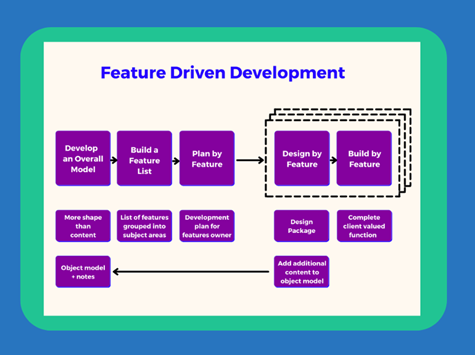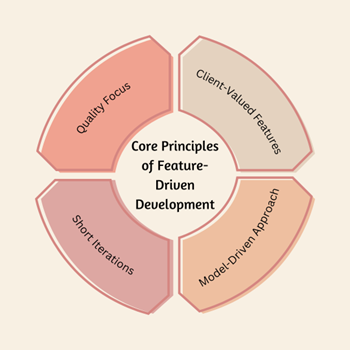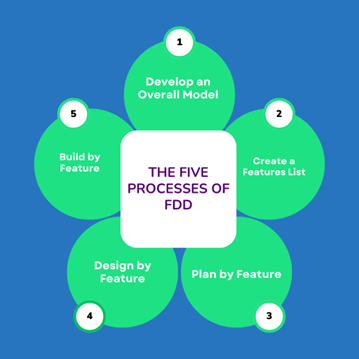Agile methodologies continue to gain more popularity in the field of software development because they are more flexible and can be improved over time.
Among these approaches is the feature-driven development in Agile, which is gaining some favorable recognition as an efficient methodology for large-scale projects. So, what is FDD in agile? If you know just the full FDD form and want to know more, you’ve come to the right place!
This blog will be able to cater to the needs of people who want a clear understanding of FDD, including its background, principles, processes, and other available agile methodologies. Other aspects that will be looked into are the benefits, difficulties, and procedures of deploying FDD in a firm.
Feature Driven Development (FDD)
FDD stands for Feature Driven Development, which is a software development methodology. It is focused on building software by iterating through small, client-valued features. In agile frameworks, FDD is known for its structured yet flexible approach, which is designed to address the challenges of large and complex projects.
Unlike Scrum or Extreme Programming (XP), Feature Driven Development uses a more model-driven approach. In feature-driven development, features are designed, developed, and delivered in short, efficient cycles.

The FDD meaning in software engineering boils down to providing incremental progress through the continuous delivery of working features. It focuses on achieving specific functionalities that clients value, ensuring that progress is tangible and transparent.
The History and Origins of FDD
FDD was developed in 1997 by Jeff De Luca and Peter Coad during a large-scale project for a Singaporean bank. At that time, the software development industry was looking for methodologies that would handle large teams and complex requirements efficiently. FDD was designed to combine the structure of traditional waterfall methodologies with the flexibility of agile principles, making it one of the first agile methodologies tailored specifically for large organizations.
Core Principles of Feature-Driven Development

Feature-driven development in Agile is based on a set of core principles that define how the methodology works and what makes it different from other agile approaches. Let’s explore these principles:
Client-Valued Features
Feature-driven development in Agile emphasizes the development of features that are valuable to the client. These are small, functional increments of the software that can be developed in short timeframes, typically two weeks. The idea is to deliver something useful to the client at regular intervals, ensuring that progress is measurable and aligned with the project’s objectives.
Model-Driven Approach
Unlike some agile methodologies that start with development right away, feature-driven development uses a model-driven approach. Agile teams first create a high-level domain model that represents the core functionalities of the system. This model is then broken down into smaller, manageable features. By focusing on understanding the domain before diving into development, FDD agile reduces the risk of rework and ensures that the development is aligned with the business goals.
Short Iterations
Feature-driven development emphasizes short, time-boxed iterations for each feature. Each iteration typically spans two weeks, allowing for rapid feedback, quick problem resolution, and continuous improvement. This short cycle helps maintain momentum and ensures that the development process remains adaptable.
Quality Focus
Feature-driven development places a strong emphasis on quality at every stage of development. The team is expected to follow coding standards, perform regular inspections, and ensure that the final product meets the client’s expectations. Quality checks are embedded throughout the development process, making FDD agile particularly useful for projects that require high levels of accuracy and reliability.
The Five Processes of FDD

FDD in software engineering is based on five main activities that define how the methodology operates. These processes guide the development of features from conceptualization to deployment.
Develop an Overall Model
The team begins by creating an overall domain model that outlines the core functionality of the system. This model acts as the foundation upon which all features will be built. It involves input from domain experts and stakeholders to ensure accuracy and relevance.
Build a Features List
Once the model is established, the team breaks it down into a list of client-valued features. These features are small and granular, allowing them to be completed in short iterations. The features list helps the team prioritize tasks and ensures that the project is aligned with the client’s needs.
Plan by Feature
In this Feature-driven development agile stage, the features are prioritized, and a development plan is created. Each feature is assigned to a small team or individual, and a schedule is developed to track progress. The planning process helps in resource allocation and ensures that deadlines are met.
Design by Feature
For each feature, the team conducts a detailed design phase. This includes identifying the necessary components, creating class diagrams, and preparing for development. The design process is collaborative, involving class owners and chief programmers to ensure consistency.
Build by Feature
Finally, the feature is built, tested, and integrated into the larger system. The build-by-feature process involves coding, unit testing, and quality assurance checks to ensure that the feature meets the required standards before it is deployed.
Key Roles in FDD
FDD agile defines several key roles within a project, each with distinct responsibilities to ensure smooth operation and accountability.
Project Manager
The project manager has the duty to oversee the entire development process, from planning to execution. They ensure that the project remains on track, meets deadlines, and adheres to the budget.
Chief Architect
The chief architect in FDD is responsible for the overall design of the system. They create the initial domain model and ensure that all features fit cohesively within that structure.
Development Manager
The development manager runs the daily activities of the development team. They supervise personnel, distribute workloads and ensure that development objectives are achieved.
Chief Programmers
The chief programmers supervise sub-teams which work on particular features. They lead their teams during design-bid-build and testing phases to make sure that during the cycle of activity, there is conformity with project requirements.
Class Owners
Class owners are responsible for specific classes in the codebase. They ensure that their classes remain up-to-date and function correctly as new features are added.
Advantages of Feature-Driven Development
Feature-driven development offers several advantages, particularly for large-scale projects that require structured yet flexible processes.
Rapid Development and Delivery
FDD’s focus on small, client-valued features ensures that the development process is quick and efficient. Features can be delivered rapidly, providing immediate value to the client and allowing for faster feedback cycles.
Improved Quality Control
The emphasis on design, code reviews, and testing ensures that superior code quality is maintained throughout the entire product development process. Regular inspections help catch issues early, reducing the risk of defects in the final product.
Enhanced Project Visibility
FDD’s structured approach provides clear visibility into project progress. The use of feature lists, iteration plans, and regular reporting ensures that all stakeholders are kept informed, reducing the risk of miscommunication.
Scalability for Large Projects
FDD agile is particularly well-suited for large projects with complex requirements. Its model-driven approach and structured processes allow for scalability, making it easy to manage large teams and intricate systems.
Challenges and Limitations of FDD
Despite its advantages, FDD does have some challenges and limitations.
Dependency on Domain Experts
FDD in software engineering relies heavily on domain experts to develop the initial model. If domain knowledge is lacking, the model may not accurately represent the business needs, leading to problems later in the project.
Less Emphasis on Customer Collaboration
Other agile methodologies like Scrum approach require seeking customer feedback on a regular basis during development, FDD is uniquely different as there is no constant need for subsequent regular communication with the customer during the development stage. That may create gaps in development team-client relations.
Potential for Feature Overload
It is possible that because FDD in software engineering relies on introducing a great number of tiny features, there is a possibility of feature creep. Such a situation may lead to a situation where the software becomes fragile due to its complexity over time and is costly to maintain and enhance.
FDD vs. Other Agile Methodologies
FDD vs. Scrum
While both FDD and Scrum are agile methodologies, they have different approaches. Scrum focuses on iterative sprints and continuous customer feedback, while FDD emphasizes a model-driven approach and short iterations for specific features. FDD is more suited for large, complex projects, while Scrum is often preferred for smaller teams.
FDD vs Extreme Programming (XP)
Extreme Programming (XP) emphasizes continuous testing, pair programming, and frequent releases. FDD, on the other hand, focuses on detailed design and feature-driven iterations. XP is more customer-centric, while FDD Agile is more structure-driven.
Implementing FDD in Your Organization
Steps to Adopt FDD
- Understand the Model-Driven Approach: Ensure your team has the necessary domain knowledge.
- Build a Features List: Break down your project into client-valued features.
- Assign Roles: Clearly define the roles of project managers, chief programmers, and class owners.
- Plan Iterations: Set short, time-boxed iterations for each feature.
- Focus on Quality: Implement regular inspections and testing throughout the development process.
Best Practices for Success
- Ensure that domain experts are involved in the process from the start.
- Maintain clear communication with all stakeholders.
- Keep features small and manageable to avoid bloat.
- Perform regular code reviews to maintain quality.
Tools and Resources for FDD
- JIRA: For task and feature tracking.
- Confluence: For documentation and collaboration.
- GitLab: For managing source code and CI/CD.
- Feature Plan: A dedicated tool for managing feature lists.
Conclusion: Is FDD Right for Your Project?
Feature Development is a structured but also adaptable software development process, especially for larger, more complicated projects.
It allows organizations with recognizable needs and domain understanding to be able to focus on valued features, quality assurance, and scalability. On the other hand, FDD may not be suitable for projects that require continuous interaction with customers or have changing features.
In the end, it is important to stress that FDD should be applied considering the requirements of the project, the specialization of the team, and the expectations regarding the level of complexity.






Add comment